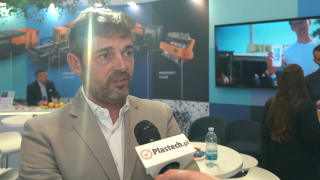
More sustainability, creation of a circular economy, fluctuating raw material and energy prices - these current challenges are bringing in-house recycling of sprue and production scrap into focus. It pays off to check into which products regrind can be blended. A well-known manufacturer of electronic components has been able to cut unit costs in injection molding production thanks to in-house recycling. The new S-Max 2 granulators from Wittmann paid back their purchase price within just six months.
The processing company manufactures sophisticated electronic components on 15 injection molding machines with clamping forces ranging from 15 to 120 tons. These include many different plugs and connectors for technical and industrial applica-tions.
“We are using many of our products here ourselves”, explains the injection molding department manager. “For example, in the injection molding machines and robots. This is certainly a decision-making factor in choosing our suppliers”.
The most recently acquired machines on the company’s production floor - two ser-vo-hydraulic SmartPower models - have come from Wittmann. The energy effi-ciency of Wittmann injection molding technology was a further consideration in favor of choosing this equipment.
Blending in up to 25 per cent regrind
The cooperation with Wittmann has already existed for many years, since in mate-rials handling the processor also relies on solutions from Austria. Wittmann sup-ports every project with extensive know-how, counseling and solutions tailored pre-cisely to fit the customer’s needs.
Nevertheless, the market is analyzed thoroughly for each new project, and products from several different suppliers are always evaluated. Most recently, this was done two years ago, when the company decided to recycle sprue and production scrap in-house and return them to the injection molding process.

For a long time, it was considered impossible for customers to accept a proportion of recycled material in their parts. But the current demand for a circular economy has prompted the industry to rethink this point. “We have carried out numerous tests with recycled materials and thoroughly analyzed the quality of the injection molded parts”, explains the injection molding department manager. “Many plugs have fili-gree structures with thin-walled areas. We had to make sure that we can fill the cavi-ties completely and maintain the required product attributes with recycled material, too.”
The tests proved successful. The percentage of regrind which can be blended in with the virgin material was defined for each individual product. Up to 25 per cent is possible for parts produced at the company’s facility.
Easy grinding of parts with high fiberglass content
Sprue and production scrap such as start-up parts and rejects are now collected in boxes at the machines and brought to the new recycling center by the machine op-erators. This center is located in the middle of the injection molding hall and consists of four brand-new S-Max 2 granulators from Wittmann. A separate lattice box is placed in front of the granulators for each different variety and color of main materi-al. Strict single-variety collection of scrap to be processed is an important prerequi-site for producing high-quality parts from regrind.
The main materials include various types of polyamides as well as PBT, ABS and polypropylene, all flame retardant modified and mixed with fiberglass. Materials with very high fiberglass contents of up to 60 per cent are being processed.
As soon as a lattice box is full, one of the granulators is started. The recycling center is operated and supervised by the injection molding staff. So, the overall responsibil-ity lies in one hand.




